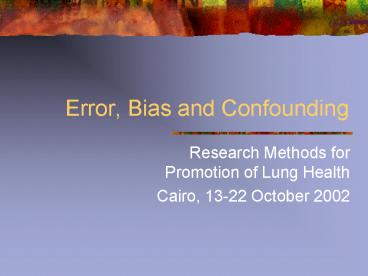Error, Bias and Confounding - PowerPoint PPT Presentation
1 / 22
Title:
Error, Bias and Confounding
Description:
Size of induration, mm. Systematic Error. Per Cent. Sources of Selection Bias ... We want to study the association of stigma with diagnosis of TB ... – PowerPoint PPT presentation
Number of Views:198
Avg rating:3.0/5.0
Title: Error, Bias and Confounding
1
Error, Bias and Confounding
- Research Methods for Promotion of Lung Health
- Cairo, 13-22 October 2002
2
Types of Error
- Random error
- Systematic error
- Selection bias
- Information bias
3
Random Error
Per Cent
Size of induration, mm
4
Systematic Error
Per Cent
Size of induration, mm
5
Sources of Selection Bias
- Inappropriate population studied
- Inadequate participation
- Change of classification of the determinant
- Selection of most accessible or of volunteers
6
Inadequate Participation
- We want to study the association of stigma with
diagnosis of TB - We select a sample of the population
- 20 of the sample agree to participate
- We find that there is no association of stigma
with TB - Is this true?
7
Inappropriate Population
- We wish to measure the impact of HIV on
tuberculosis - We study the trend of tuberculosis in Egypt from
1997 to 2001 - We find no change in notification rate
- We conclude that HIV has no impact on TB
- Were we right?
8
Classification of Determinant
- We want to study the impact of poverty on the
trend of tuberculosis in Damascus - We select a poor district and a rich district and
compare the notification of TB from 1991 to 2000 - In the meantime, there is an urban renewal
project in the poor district - We find no difference between the districts
- Can we conclude that poverty is not related to TB?
9
Participation of Volunteers
- We want to determine the prevalence of HIV
infection in Syria - We ask for volunteers for testing
- We find no HIV
- Is it correct to conclude that there is no HIV in
Syria?
10
Minimizing Selection BiasStudy Design
- Appropriate population selection
- High participation rate
- Demonstration of lack of difference between
participants and non participants
11
Minimizing Selection BiasAnalysis
- Exclude from numerator and denominator
- Analyze by time at risk
- Worst and best case scenarios
12
Source of Information Bias
- Subject variation
- Observer variation
- Deficiency of tools
- Technical errors in measurement
13
Subject Variation
- We want to determine the association of knowledge
about TB and notification of TB - We interview TB patients in a public clinic and
those in a private practice - The public clinic has a program of health
education - We find that those who know about TB are notified
and those who do not are not - Is it correct that there is an association
between knowledge about and notification of TB?
14
Observer Variation
- We carry out a case control study of poverty and
tuberculosis - We accept any case diagnosed by a doctor
- The doctor knows that poor people are more likely
to have TB - Can this knowledge bias the result?
15
Technical Errors
- We want to test a new antigen for the diagnosis
of tuberculosis - We select a case control study
- By chance, the batch of the antigen we use for
the cases has been left unrefrigerated - We find no difference in response to the antigen
between cases and controls
16
Minimizing Information Bias
- Specify criteria in advance
- Analyze directly according to criteria
- Reduce numbers of observers
- Monitor performance of observers
- Use standardized tools for measurement
17
ConfoundingA Special Type of Bias
- A factor associated with both the outcome and a
determinant (an etiological factor) - Therefore associated with outcome through its
association with the determinant (etiological
factor)
18
ConfoundingKnowledge about and Notification of TB
- Recall the study of knowledge of and notification
of TB - TB patients are educated about TB in the public
sector but not in the private - Educated TB patients are notified and those not
educated are not - The real reason for notification is the type of
practice and not the knowledge of TB
19
Confounding
Confounder (Knowledge)
Determinant (Type of Practice)
Outcome (Notification)
20
ConfoundingAge and tuberculosis
- We find a higher proportion of reported TB cases
in rich countries are older men - We conclude that advancing age is a risk factor
for tuberculosis - Is this correct?
21
Tuberculosis Notification RateNorway, by Age
Per 100 000
1927
1947
1980
Age, years
Nor Fore Lunge 198630
22
Impact of Error or Bias
- Random error will obscure a real difference
- Random error will require a larger sample size
- Bias will result in false difference
- It cannot be overcome by statistics if present































